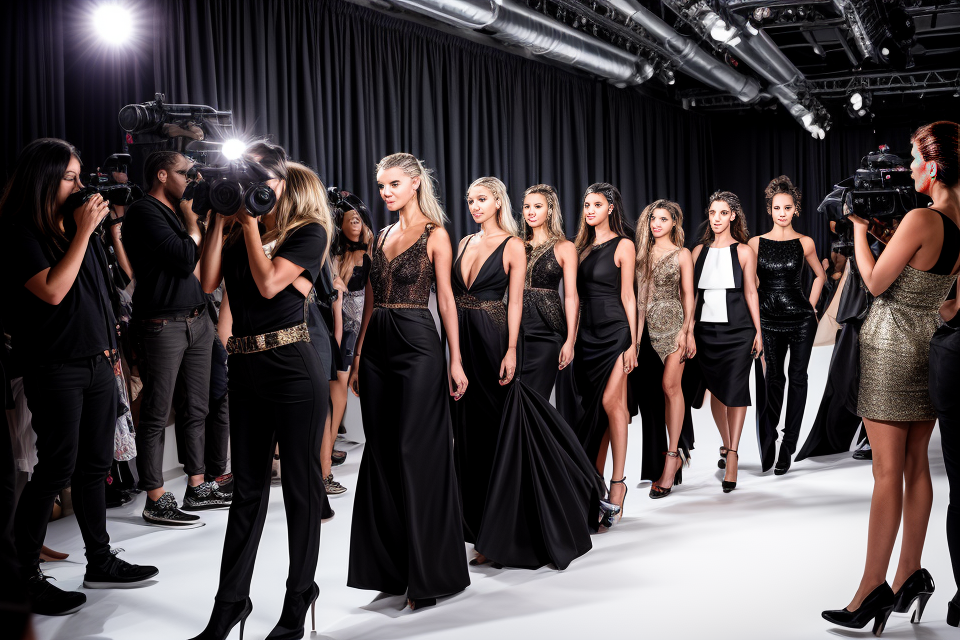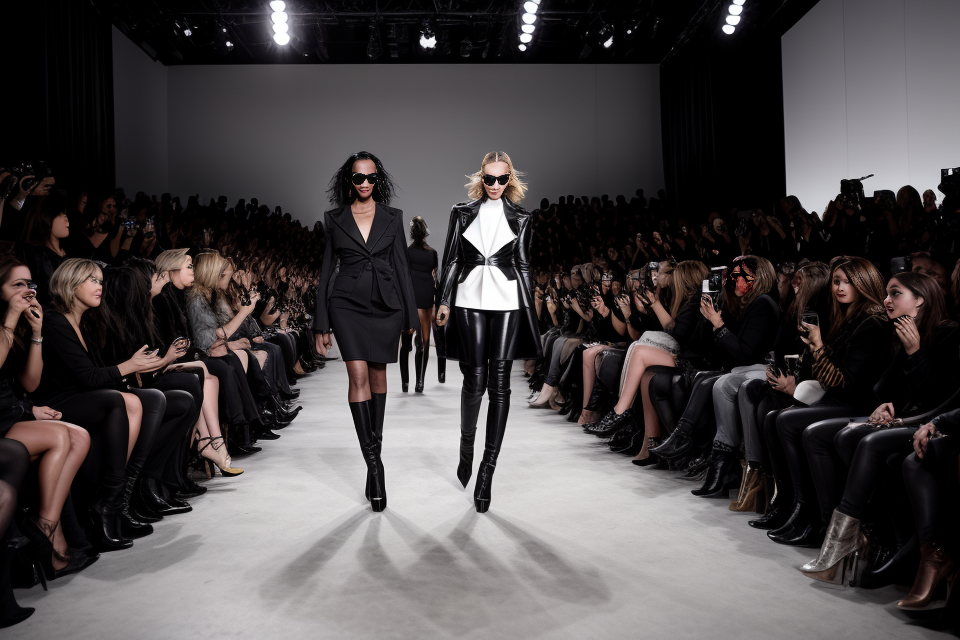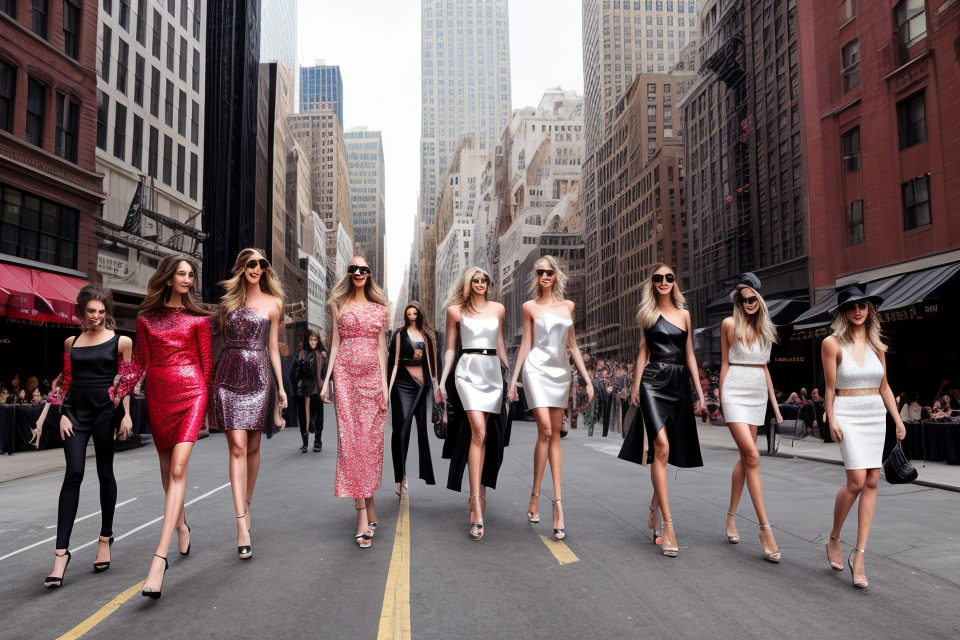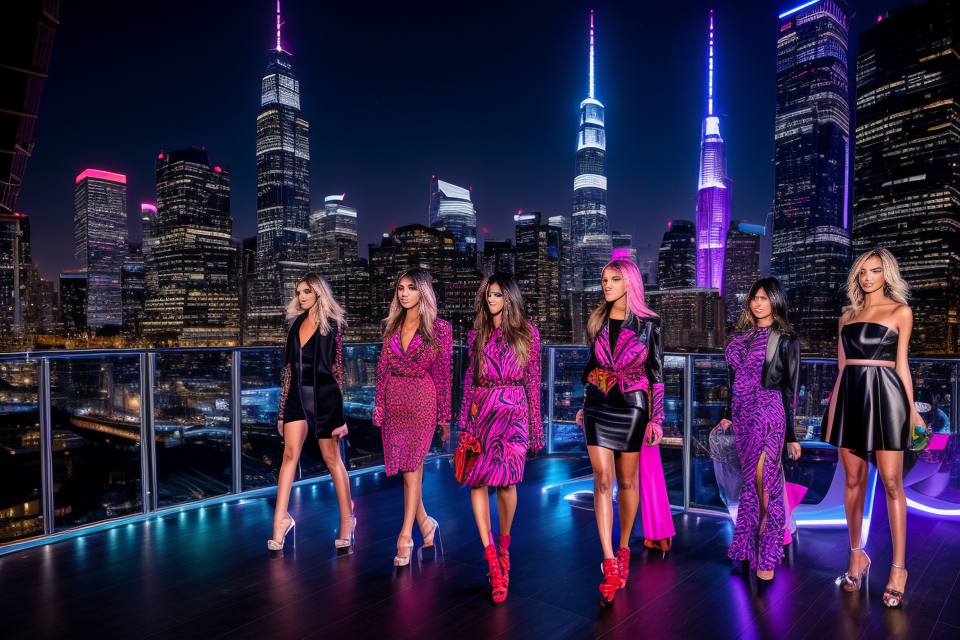
Fashion shows are a dazzling spectacle of style, creativity, and glamour. From the catwalk to the runway, these events showcase the latest trends and designs from top fashion houses around the world. But have you ever wondered how these shows are held? In this insider’s guide, we’ll take a behind-the-scenes look at the world of fashion events and explore the intricacies of planning and executing a successful fashion show. From the models to the lighting, we’ll cover everything you need to know to understand the magic behind the curtain. So get ready to discover the fascinating world of fashion shows and learn how they are held.
The Basics of a Fashion Show
What is a Fashion Show?
A fashion show is a public event organized to showcase the latest fashion trends and designs from clothing and accessories to footwear and beauty products. These events are held for various purposes, including to promote and market new fashion collections, showcase the work of emerging designers, and provide inspiration and entertainment for fashion enthusiasts.
Types of Fashion Shows:
There are several types of fashion shows, each with its own unique purpose and format. Some of the most common types of fashion shows include:
Runway Shows
Runway shows are the most popular type of fashion show, featuring models walking down a runway wearing the latest designs from a particular fashion label or designer. These shows are often held during major fashion weeks in cities such as New York, London, Paris, and Milan, and are attended by fashion buyers, journalists, and other industry professionals.
Trunk Shows
Trunk shows are smaller, more intimate events held by designers or boutiques to showcase their latest collections. These shows are often held in a boutique or showroom setting, and may feature food, drinks, and live music in addition to the fashion presentations.
Couture Shows
Couture shows are high-end fashion events featuring custom-made, handcrafted garments made from high-quality materials. These shows are typically held during major fashion weeks and are attended by the most elite fashion buyers and collectors.
Pop-Up Shows
Pop-up shows are temporary events held in unexpected locations, such as vacant storefronts or repurposed warehouses. These shows are often used to generate buzz and excitement around a new fashion brand or collection.
Charity Shows
Charity shows are fashion events held to raise money for a particular cause or organization. These shows may feature celebrity hosts, auctions, and other fundraising activities in addition to the fashion presentations.
Virtual Shows
Virtual shows are fashion events held online, featuring live-streamed runway shows, virtual reality experiences, and other digital content. These shows have become increasingly popular in recent years, especially during the COVID-19 pandemic, as a way to reach a wider audience and reduce the environmental impact of fashion events.
The Purpose of a Fashion Show
- Promoting new designs and collections
Fashion shows serve as a platform for designers to showcase their latest creations to industry professionals, buyers, and the media. The primary goal is to generate interest in the new designs and encourage sales. The showcase provides an opportunity for buyers to see the clothes up close, evaluate the quality, and place orders for their stores. - Building brand awareness and exposure
Fashion shows help designers establish and maintain their brand identity. They create a unique image and style that sets them apart from competitors. By showcasing their work, designers can generate media coverage and attract the attention of potential customers. This exposure helps build a loyal following and establish the designer’s reputation in the industry. - Networking and connecting with industry professionals
Fashion shows are also a platform for industry professionals to connect and network. Designers, models, photographers, stylists, and other fashion insiders attend shows to meet each other, exchange ideas, and forge collaborations. These connections can lead to future opportunities, such as partnerships, collaborations, or even job offers. The fashion show provides a dynamic and vibrant environment for professionals to connect and build relationships that can benefit their careers.
The Elements of a Fashion Show
A fashion show is an event that showcases a designer’s latest clothing and accessories collection. The event typically features models walking down a catwalk or runway, wearing the designer’s creations. The fashion show is a critical marketing tool for designers, allowing them to showcase their work to industry professionals, buyers, and the media. In this section, we will take a closer look at the elements that make up a fashion show.
Clothing and Accessories
The primary focus of a fashion show is the clothing and accessories that are being showcased. Designers spend months creating their collections, and the fashion show provides an opportunity to showcase their work to a wider audience. The clothing and accessories featured in a fashion show can range from casual streetwear to high-end haute couture. Each piece is carefully chosen to reflect the designer’s aesthetic and vision.
Models
Models are an essential element of a fashion show. They are the ones who wear the clothing and accessories and bring the designs to life. Designers carefully select models who fit their aesthetic and can showcase their work effectively. Models are often trained to walk down the runway in a specific way, using certain poses and facial expressions to convey the designer’s vision.
Catwalk and Stage
The catwalk or runway is the central element of a fashion show. It is where the models walk down, showcasing the clothing and accessories. The catwalk is typically designed to be the focal point of the show, with the audience seated around it. The stage can be designed in a variety of ways, depending on the designer’s vision. It can be simple and minimalist or elaborate and dramatic.
Lighting and Sound
Lighting and sound are crucial elements of a fashion show. Lighting is used to create a specific mood and atmosphere, highlighting the clothing and accessories in a way that is visually appealing. Designers often work with lighting experts to create a specific look for their show. Sound is also used to enhance the overall experience, with music playing in the background and sound effects used to create a dramatic effect.
Overall, the elements of a fashion show work together to create a cohesive and memorable experience for the audience. From the clothing and accessories to the models, catwalk, and lighting, each element plays a critical role in showcasing the designer’s work and capturing the audience’s attention.
The Planning and Preparation for a Fashion Show
The Role of Designers and Teams
The role of the designer
A fashion show is often the culmination of months of hard work and creativity by a designer. The designer is responsible for conceptualizing and creating the clothing and accessories that will be showcased on the runway. This includes selecting fabrics, creating patterns, and constructing garments.
The designer also plays a key role in the overall aesthetic of the show. They work with the fashion show team to select models, create the set, and choose the music that will accompany the show. The designer’s vision for the collection is the driving force behind the entire event.
The fashion show team
In addition to the designer, there are many other members of the fashion show team who work tirelessly to bring the event to life. This includes producers, stylists, hair and makeup artists, photographers, and publicists.
The producers are responsible for coordinating all aspects of the show, including scheduling, logistics, and budgeting. They work closely with the designer to ensure that the show runs smoothly and meets the designer’s vision.
The stylists are responsible for selecting the clothing and accessories that will be worn by the models. They work closely with the designer to ensure that the models are dressed appropriately for the show.
Hair and makeup artists are responsible for creating the overall look of the models. They work closely with the stylists and the designer to select hair and makeup styles that complement the clothing and accessories.
Photographers are responsible for capturing the essence of the show. They work closely with the designers and the producers to get the perfect shots of the models and the clothing.
Publicists are responsible for promoting the show and generating buzz. They work closely with the designers and the producers to get the word out about the show and create a media frenzy around it.
The importance of collaboration
The success of a fashion show depends on the collaboration of many different individuals and teams. The designer is the driving force behind the show, but they cannot do it alone. The fashion show team must work together to bring the designer’s vision to life.
Effective communication and collaboration are essential to the success of a fashion show. The producer must work closely with the designer to understand their vision and ensure that the show is executed flawlessly. The stylists must work closely with the designer to select the right clothing and accessories for the models. The hair and makeup artists must work closely with the stylists and the designer to create the perfect look for the models.
In addition to the members of the fashion show team, there are also many other individuals who play a role in the success of the show. Models, for example, must be selected carefully to ensure that they are the right fit for the clothing and the overall aesthetic of the show. The venue must also be selected carefully to ensure that it can accommodate the show and provide the right atmosphere.
Overall, the success of a fashion show depends on the collaboration of many different individuals and teams. Each member of the fashion show team must work together to bring the designer’s vision to life and create a memorable event.
Choosing the Venue and Invitees
When it comes to choosing the venue for a fashion show, there are several factors that must be considered. One of the most important is the size of the venue. It needs to be large enough to accommodate the expected number of guests, as well as the runway and seating area. The venue should also have good lighting and sound systems, as well as a suitable location that is easily accessible for guests.
Building the guest list is another crucial aspect of planning a fashion show. It is important to invite the right people, such as industry professionals, media representatives, and potential buyers. The guest list should also reflect the brand’s target audience, as well as the overall theme and aesthetic of the show.
Timing and scheduling are also key factors to consider when choosing a venue and building the guest list. The show should be scheduled at a time that is convenient for the guests, as well as the designers and their teams. It is also important to consider any potential conflicts with other events or schedules, as well as the availability of the venue itself.
Overall, choosing the right venue and building the guest list requires careful consideration and planning. It is important to select a venue that is suitable for the show and its intended audience, and to invite the right people to ensure a successful event.
Marketing and Promotion
The success of a fashion show depends not only on the quality of the clothing and the stage production but also on the ability to effectively market and promote the event. In today’s fast-paced and highly competitive fashion industry, marketing and promotion play a crucial role in creating buzz and generating interest in a fashion show. Here are some of the key aspects of marketing and promotion for fashion shows:
The Importance of Marketing and Promotion
Marketing and promotion are essential components of a successful fashion show. They help to create awareness and generate interest in the event, attract media coverage, and ultimately drive attendance. A well-executed marketing and promotion strategy can help to establish a brand’s identity, build anticipation and excitement around the show, and increase the chances of a successful event.
Social Media and Online Platforms
Social media and online platforms have become powerful tools for promoting fashion shows. Designers and fashion brands can use social media platforms such as Instagram, Twitter, and Facebook to reach a wide audience and build buzz around their events. Social media can be used to share behind-the-scenes content, teasers, and sneak peeks of the collections, and to engage with fans and followers. In addition, designers can use online platforms such as fashion blogs and websites to showcase their work and generate interest in their shows.
Press Releases and Media Coverage
Press releases and media coverage are critical components of a successful marketing and promotion strategy for fashion shows. Designers and fashion brands can use press releases to announce their shows, provide details about the event, and share information about the designers and their collections. Press releases can be distributed to media outlets such as fashion magazines, newspapers, and online publications to generate coverage and build buzz around the event. In addition, designers can use media coverage to increase their visibility and establish their brand identity.
Overall, marketing and promotion are essential elements of a successful fashion show. By using a combination of social media, online platforms, and traditional press releases and media coverage, designers and fashion brands can create awareness, generate interest, and drive attendance to their events.
The Production and Execution of a Fashion Show
The Day of the Show
The day of the fashion show is a frenzied whirlwind of activity, with many moving parts and stakeholders to manage. From the early morning hours, the venue is transformed into a spectacular setting for the show, with lights, sound systems, and stage setups installed. The models and stylists arrive for hair and makeup, while the designers and their teams are busy finalizing the order of the show and ensuring that each outfit is presented to perfection.
Here are some of the key events that take place on the day of the show:
The Timeline of Events
The day of the fashion show is typically divided into several key events, each of which is carefully choreographed to ensure that the show runs smoothly. Here is a typical timeline of events:
- 8:00 AM – 9:00 AM: Arrival and preparation of the venue
- 9:00 AM – 10:00 AM: Setup of lighting, sound, and stage
- 10:00 AM – 12:00 PM: Hair and makeup for the models
- 12:00 PM – 1:00 PM: Sound check and rehearsal of the models’ walk
- 1:00 PM – 3:00 PM: Lunch break and final preparations
- 3:00 PM – 6:00 PM: Fashion show
- 6:00 PM – 7:00 PM: Dressing room and backstage area cleanup
- 7:00 PM – 8:00 PM: Post-show celebration or debriefing
Pre-Show Preparations
Before the show can begin, there are several pre-show preparations that must be made. These include:
- Designer and Model Meetings: The designer and model meetings are typically held in the days leading up to the show. During these meetings, the designer and model discuss the outfit and how it should be presented on the runway.
- Hair and Makeup Trials: The models undergo hair and makeup trials in the days leading up to the show to ensure that they are camera-ready and that their looks complement the designer’s collection.
- Runway Rehearsals: The models practice their walk on the runway to ensure that they can showcase the designer’s collection to its best advantage.
Backstage Management
During the show, there is a lot of activity backstage, with stylists, designers, and other members of the team working to ensure that everything runs smoothly. Here are some of the key tasks that take place backstage:
- Model Dressing: The models are dressed in their outfits, and their hair and makeup are touched up as needed.
- Outfit Presentation: The outfits are presented on the runway in the correct order, with each model walking out to the appropriate song and posing for the cameras.
- Choreography: The models’ walk is choreographed to ensure that they present the outfits to their best advantage.
- Wardrobe Changes: If the designer has multiple outfits in the show, the models may need to change quickly between outfits, which requires careful coordination and organization.
Overall, the day of the fashion show is a carefully choreographed and coordinated event that requires a lot of planning and execution. From the early morning hours to the post-show celebration or debriefing, every detail is carefully managed to ensure that the show is a success.
The Catwalk and Runway
The Importance of the Catwalk and Runway
The catwalk and runway are the central features of a fashion show, serving as the stage for models to showcase the latest designs and trends. The runway’s design and layout play a crucial role in the overall presentation of the fashion show, as it provides a clear and organized space for the models to walk and display the clothing. The catwalk and runway are essential components of the fashion show production, as they set the tone for the entire event and serve as the primary focal point for the audience.
The Choreography of the Show
The choreography of a fashion show is a carefully planned and executed sequence of events that is designed to showcase the clothing in the most effective way possible. The choreography of a fashion show involves a variety of elements, including the models’ walking patterns, the timing of the music, and the lighting design. The choreography of a fashion show is often developed in collaboration with a team of professionals, including fashion designers, stylists, and choreographers, who work together to create a cohesive and visually stunning presentation.
Working with Models
Working with models is an essential aspect of the fashion show production process. Models are selected based on their physical appearance, as well as their ability to walk the runway and showcase the clothing in the most effective way possible. Models are typically trained in walking techniques and posing, and they work closely with the fashion designers and stylists to understand the vision for the show. Models play a critical role in the success of a fashion show, as they bring the clothing to life and help to convey the designer’s message to the audience.
The Aftermath of the Show
- Post-show activities
- Cleanup and breakdown of the venue
- Packing up and transporting of the clothes, accessories, and set pieces
- De-briefing and evaluation of the show’s success
- Feedback and analysis
- Collecting feedback from attendees, media, and industry professionals
- Analyzing the social media and press coverage of the show
- Reviewing the financial and logistical aspects of the event
- Lessons learned and improvements for future shows
- Identifying what worked well and what needs improvement
- Making adjustments to the production process, design, and marketing strategy
- Planning for the next fashion show or event.
FAQs
1. How are fashion shows organized?
Fashion shows are typically organized by fashion designers, fashion houses, or fashion event organizers. They involve planning and coordinating various aspects such as selecting a venue, inviting guests, hiring models, creating a runway, and choosing the clothing and accessories to be showcased.
2. What is the purpose of a fashion show?
The primary purpose of a fashion show is to showcase a designer’s or fashion house’s latest collection of clothing and accessories to industry professionals, buyers, media, and other guests. Fashion shows also provide an opportunity for designers to gain exposure, network with industry professionals, and receive feedback on their designs.
3. How long do fashion shows usually last?
The duration of a fashion show can vary depending on the number of designs being showcased and the format of the show. Typically, a fashion show can last anywhere from 15 minutes to an hour or more.
4. Who attends fashion shows?
Fashion shows are typically attended by industry professionals such as buyers, journalists, stylists, and photographers. However, some shows are open to the public and can attract fashion enthusiasts and celebrities.
5. What happens during a fashion show?
During a fashion show, models walk down a runway wearing the designer’s or fashion house’s latest collection of clothing and accessories. The audience watches as the models showcase the clothes, which are often accompanied by music and lighting effects. After the show, the designer or fashion house may hold a presentation or press conference to discuss the collection and answer questions from the media.
6. How are fashion shows different from runway shows?
Fashion shows and runway shows are often used interchangeably, but they can refer to slightly different types of events. A fashion show typically includes a presentation or press conference in addition to the runway show, while a runway show may focus solely on the clothing and accessories being showcased on the runway.
7. How many shows do designers typically present each year?
The number of shows that designers present each year can vary depending on the designer and their schedule. Some designers may present multiple collections per year, while others may only present one or two. The frequency of fashion shows can also depend on the fashion calendar, which is typically divided into seasonal collections (spring/summer, fall/winter).


